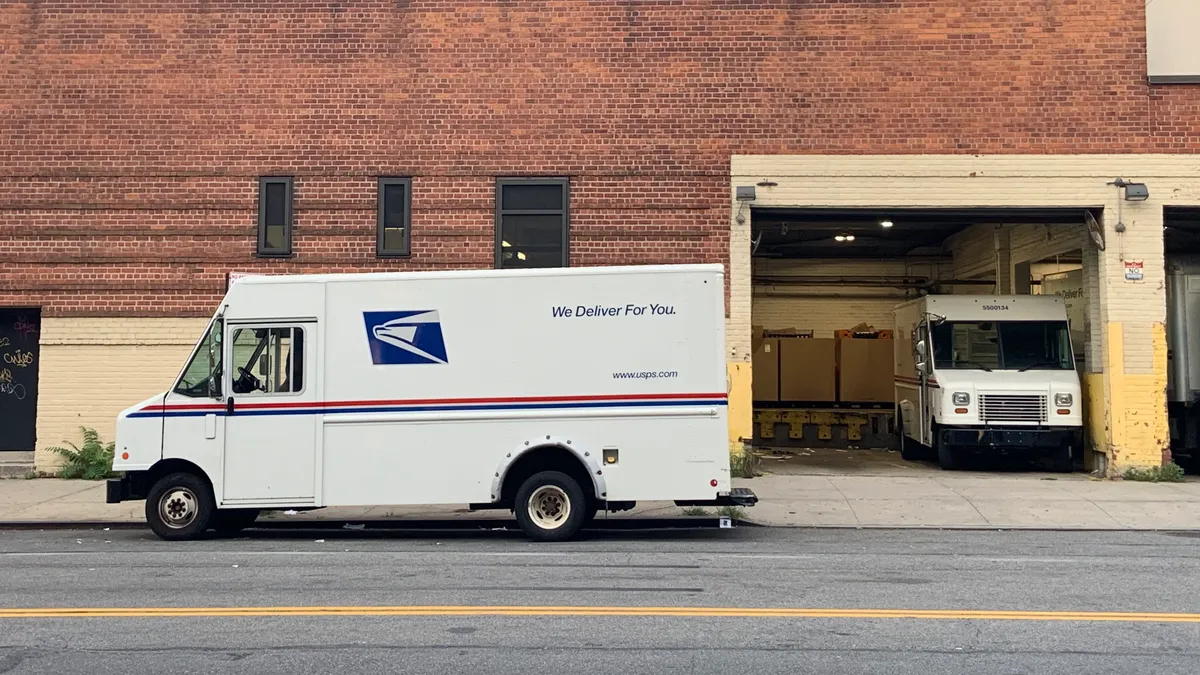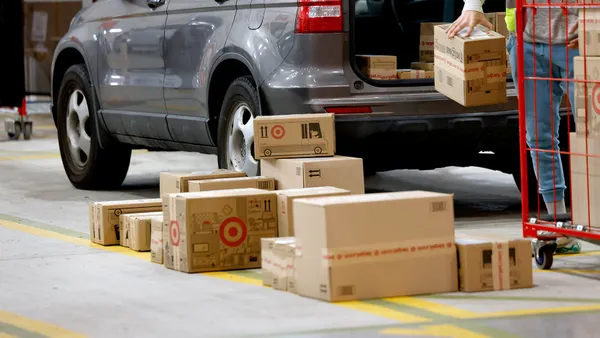As grocers scout for strategies to maintain the powerful sales momentum they've built during the coronavirus pandemic, pickup is emerging as a candidate that's especially ripe for innovation.
Consumers have embraced buy online, pick up in store at a breakneck pace during the past year. Albertsons recently reported that its Drive Up & Go offering grew 800% in the company’s latest quarter, and Target said its Drive Up service surged 500% during November and December.
But while surging channel demand presents an opportunity for retailers to strengthen their ties with shoppers and bring in added revenue, it also poses challenges as store owners look for the physical space and labor they need to support their booming online businesses, according to e-commerce experts.
"For retailers, every square foot matters. They don’t necessarily have a lot of excess space," said Jeremy Neren, co-founder and CEO of GrocerKey, which provides e-commerce technology to grocers including Woodman's Market, an 18-store chain that operates stores in Illinois and Wisconsin. "So as e-commerce becomes a bigger percentage of sales, it becomes a real issue of where are we going to store this product and where are we going to stage it from the time we take [an order] till the customer comes into the store comes to pick it up."
Making the pickup process effective
Retailers looking to counter those obstacles are experimenting with ways to make pickup more efficient, in terms of both square footage and customer convenience. At the intersection of both points sit order storage units, both automated and non-automated, which have undergone testing by grocers in recent years and are gaining renewed interest as companies seek new ways to meet booming e-commerce demand.
In October, Albertsons announced that it intended to test lockers at selected Jewel-Osco stores in Chicago and Safeway locations in the San Francisco Bay Area. The temperature-controlled units, made by North Carolina-based Bell and Howell, are designed to preserve hot and cold items after store staff have finished assembling orders. Shoppers can choose when they intend to pick up their goods when placing an order online.
“As e-commerce becomes a bigger percentage of sales, it becomes a real issue of where are we going to store this product and where are we going to stage it from the time we take [an order] till the customer comes into the store comes to pick it up.”

Jeremy Neren
Co-founder and CEO, GrocerKey
Albertsons is also trying out more sophisticated storage systems. In Chicago, technology integrator Telaid recently installed an automated pickup kiosk outside a Jewel-Osco store.
The unit, which is made by Estonian technology firm Cleveron and features regular and deep-freeze sections, routes items to a central pickup space built into the unit. Customers select a two-hour pickup time frame in advance and, upon arrival, request their order by scanning a code displayed on a smartphone. Albertsons plans to place another such kiosk at a San Francisco-area Safeway at a later point, according to the company.
Other retailers that operate pickup lockers include Amazon and Home Depot. Home improvement retailer Lowe's said in September that it plans to install lockers chainwide by the end of March. Walmart, meanwhile, has tested automated grocery pickup terminals in the past and has Cleveron-made pickup towers at hundreds of stores.
A key advantage offered by pickup lockers and automated kiosks is that they can add convenience for consumers by eliminating the need to wait while a store worker gets their order, said David Bishop, partner with e-commerce consultancy Brick Meets Click. The units also allow stores to deploy workers more efficiently by removing the need to assign staff to bring orders to customers when they arrive, he said.
"The lockers provide an opportunity to say, 'We're going to shift the retrieval process from the store being required to bring it out to the customer,'" Bishop said.
Pickup lockers and kiosks can also be placed away from stores, at points closer to where shoppers work and live. Retailers have experimented with off-site placement in the past, with Hy-Vee leasing its Aisles Online pickup lockers and Peapod installing pickup lockers at Washington, D.C., Metro stations. And pandemic-driven demand could spur a renewal of these efforts. In Europe, retailers like Carrefour and E. Leclerc have built standalone pickup spots in suburbs as well as cities.
Beyond streamlining the pickup process, lockers could improve the customer experience by allowing grocers to efficiently fulfill center-store orders for customers during or even before they peruse the store perimeter for items like produce and meat that shoppers often like to choose on their own, said David Gottlieb, managing director of the Americas for Trax, a provider of computer vision and analytics solutions to retailers.
"Imagine I've got a list of basics that I know I'm going to get every week. I walk into the store, I pick all my fresh items, and I come back to the register to pay, and grab my three bags that have been [set aside in a locker]. I think that could make a lot of sense," Gottlieb said.
Lockers: a complicated supply chain issue
Even as they promise convenience, however, lockers can introduce unintended headaches.
For example, consumers who prefer to have their groceries brought to their vehicle might balk at being asked to park and walk over to a locker — a factor that could limit the appeal of storage units and, by extension, the benefits they offer grocers, Bishop said.
"If we reduce the wait time to effectively zero by shifting the responsibility onto the customer, then how does the customer perceive the fact that they now have to get out of their car, go over to the locker, retrieve their packages and put them into the car themself?"
Another obstacle is that the units have a finite amount of space, meaning that some items might be too large or unwieldy to fit properly, he said.
Aside from the physical limitations, retailers who choose to use lockers and automated kiosks also have to devise strategies for ensuring their reliability, Neren said.
"It becomes a very complicated supply chain, logistics and space-management issue," Neren said. "I do think … we’ll see more of them as retailers are going to be doing a lot more of everything to solve for all the various issues associated with e-commerce. But I still think there is a little more work that needs to be done to solve for the complexities of grocery."
Retailers are also looking to storage units to enhance delivery service. Walmart, for example, plans to test temperature-controlled boxes that can store delivery orders outside homes with selected customers in Bentonville, Arkansas, later this year. Like lockers and kiosks used for pickup, the boxes Walmart is evaluating are designed to provide flexibility by removing the need for workers and customers to interact.
But they also come with restrictions. As with lockers, a central problem the units pose is their limited size, which could put delivery drivers in the uncomfortable position of having to find a way to squeeze a customer's order into a space that can't comfortably accommodate it, Bishop said.
"You can't fault the driver, because they're being told you've got to do this, and you can't fault the customer because the customer's trying to take advantage of your service," Bishop said. "Ultimately, then, if the customer [receives goods that have] damage and can quickly see that the solution isn't delivering against the promise, then the value proposition evaporates."























